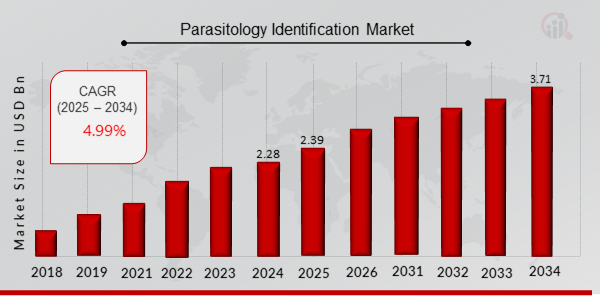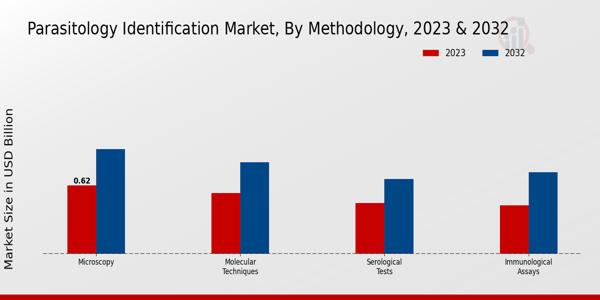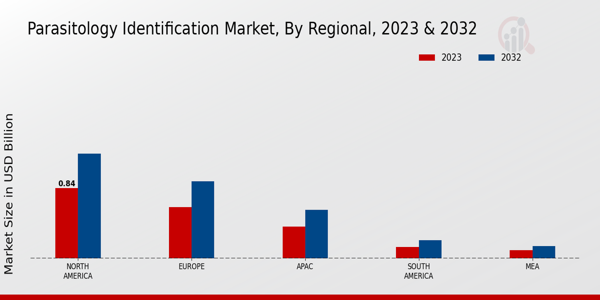Parasitology Identification Market Overview
As per MRFR analysis, the Parasitology Identification Market Size was estimated at 2.28 (USD Billion) in 2024. The Parasitology Identification Market Industry is expected to grow from 2.39 (USD Billion) in 2025 to 3.71 (USD Billion) till 2034, at a CAGR (growth rate) is expected to be around 4.99% during the forecast period (2025 - 2034).
Key Parasitology Identification Market Trends Highlighted
The Parasitology Identification Market is influenced by several key market drivers that are shaping its growth. The rising prevalence of parasitic infections, driven by factors such as climate change and increased travel, significantly boosts the demand for accurate and timely identification methods. Additionally, advancements in molecular diagnostics and laboratory technologies enhance the ability to detect parasites efficiently, leading to improved treatment outcomes. As healthcare systems prioritize patient safety and precise disease management, the focus on parasitology identification becomes more critical, highlighting the importance of reliable diagnostic tools in clinical settings.
There are numerous opportunities to be explored in the Parasitology Identification Market. The ongoing research and development efforts aimed at innovative diagnostic methods present prospects for new entrants and established companies alike. Collaborations between academia and industry could also lead to breakthroughs in identifying neglected tropical diseases. Furthermore, growing interest in personalized medicine enhances the market scope as tailored treatment for infected individuals requires a detailed understanding of their parasitic conditions. This landscape creates a favorable environment for introducing novel technologies and improving existing identification methods.
In recent times, there has been a noticeable shift towards point-of-care testing in parasitology identification. This trend caters to the need for rapid results, especially in rural or resource-limited settings, making diagnosis more accessible. Additionally, the integration of artificial intelligence and machine learning in diagnostic tools is gaining traction, allowing for more precise identification of parasitic species. Growing awareness and education regarding the impact of parasitic infections are also driving demand for effective diagnostic solutions. As stakeholders increasingly recognize the economic burden associated with parasitic diseases, investments in innovations for better identification methods are expected to rise significantly.

Source Primary Research, Secondary Research, MRFR Database and Analyst Review
Parasitology Identification Market Drivers
Growing Incidence of Parasitic Infections
The rising incidence of parasitic infections ly is a fundamental driver for the Parasitology Identification Market Industry. Factors contributing to this trend include changing lifestyles, increased travel, climate change, and urbanization, which, in turn, create favorable environments for parasites to thrive. Parasitic infections, which can lead to significant morbidity and mortality, have amplified the demand for effective detection and identification solutions in recent years.
Consequently, healthcare providers and governments are emphasizing the need for advanced diagnostic techniques, rapid testing methods, and improved surveillance systems to combat these infections. Market players are responding to this demand by investing in research to develop innovative identification technologies that promise improved accuracy and quicker results. The need for precise diagnostics is further intensified by the growing awareness among the public about health issues related to parasitic infections, coupled with the healthcare community's commitment to eradication initiatives.
The rise in vaccination programs and preventive healthcare practices also increases the need for effective tools for parasitology identification in favor of continuing the efforts, which means the market is likely to continue its upward trend.
Technological Advancements in Diagnostic Tools
Technological advancements in diagnostic tools play a significant role in driving the Parasitology Identification Market Industry. Innovations such as molecular diagnostics, next-generation sequencing, and automated assays have revolutionized the ability to identify and analyze parasitic pathogens with unprecedented accuracy and speed. These advancements enable healthcare professionals to diagnose infections at earlier stages, facilitating timely intervention and management of diseases, which is crucial in reducing morbidity rates.
Furthermore, the integration of artificial intelligence and machine learning in diagnostic processes aids in improving the interpretation of results, making it possible to detect minor parasitic infections that previously went unnoticed. This ongoing evolution of technology not only enhances the existing capabilities of diagnostic tools but also expands the clinical applications of parasitology, ensuring that healthcare settings are equipped with state-of-the-art solutions.
Increased Government Initiatives for Disease Control
Government initiatives aimed at controlling and preventing parasitic diseases are a vital market driver in the Parasitology Identification Market Industry. With the rising burden of parasitic infections, many health authorities and organizations are launching strategic initiatives and programs designed to improve diagnostic capabilities and enhance detection rates. This includes funding for research and development of novel diagnostic technologies, as well as subsidizing testing services to meet public health needs.
Additionally, international collaborations and partnerships focus on addressing health challenges posed by parasites, further stimulating the market's growth. Public awareness campaigns led by governments are also driving demand for effective identification services, emphasizing the importance of swift and accurate diagnostics as a crucial component of public health strategies.
Parasitology Identification Market Segment Insights
Parasitology Identification Market Methodology Insights
The Parasitology Identification Market demonstrates significant growth, driven by various methodologies employed for the detection and identification of parasitic infections. Within this landscape, the Methodology segment plays a critical role in shaping the market dynamics, accounting for substantial revenue generation.
In 2023, the overall market, with a value of 2.07 USD Billion, showcases various diagnostic techniques crucial for early identification of parasitic diseases. Among these, Microscopy stands out as a dominant technique, holding a value of 0.62 USD Billion in 2023 and is expected to reach 0.95 USD Billion by 2032. This method's majority holding in the market is attributed to its historical use and established credibility in identifying various parasites through direct visualization. Additionally, Molecular Techniques, valued at 0.55 USD Billion in 2023 and projected to enhance to 0.83 USD Billion by 2032, is gaining traction due to its sensitivity and specificity in detecting pathogens at the genetic level. This significant growth is spurred by advancements in technology that facilitate rapid testing and accurate identification.
Serological Tests and Immunological Assays, valued at 0.46 USD Billion and 0.44 USD Billion, respectively, in 2023, contribute to the market with their focus on antibody detection and immune response assessment. Serological Tests are projected to increase to 0.68 USD Billion by 2032, while Immunological Assays may reach 0.74 USD Billion, reflecting their importance in understanding disease prevalence and aiding in epidemiological studies. While these methodologies currently hold slightly lower valuations compared to Microscopy and Molecular Techniques, they play a significant role in the broader Parasitology Identification Market, especially in contexts where understanding the immune response to parasitic infections is essential.
The demand for innovative and efficient diagnostic methods is projected to enhance the market further, with increasing awareness and prevalence of parasitic diseases ly. This creates a competitive landscape where the advancement of methodologies remains essential for improved healthcare outcomes and the overall growth of the Parasitology Identification Market revenue. Trends such as the integration of digital technologies and the rising need for rapid test results are shaping the future of this market and reaffirming the value of all methodologies involved in parasitology identification. As each methodology adapts to changing healthcare environments, the impact they can have on patient care and epidemiological tracking underscores their significance in the Parasitology Identification Market industry.

Source Primary Research, Secondary Research, MRFR Database and Analyst Review
Parasitology Identification Market Application Insights
. This growth reflects the increasing demand for effective parasitology identification tools across various applications. The Clinical Diagnostics segment plays a crucial role, as it directly impacts patient care by enabling timely and accurate diagnoses, which is essential for treating parasitic infections. Research Laboratories are also significant as they advance the understanding of parasitic diseases and contribute to the development of new diagnostic methods.
Furthermore, the Public Health sector heavily relies on parasitology identification to monitor and control outbreaks, making it vital for disease prevention strategies. The Pharmaceuticals segment is also noteworthy, as it encompasses the development of targeted therapies and treatments, directly influencing the management of parasitic infections. Overall, the Parasitology Identification Market statistics underscore the importance of these applications in enhancing healthcare outcomes and addressing health challenges, positioning the industry for continued market growth.
Parasitology Identification Market End User Insights
Hospitals play a vital role in the identification and treatment of parasitic infections, enhancing patient care through advanced diagnostic methods. Diagnostic laboratories significantly contribute to market growth by providing precise testing services essential for accurate diagnosis and treatment plans.
Academic institutions are important as they focus on research and development, advancing knowledge in parasitology and fostering innovation in identification technologies. Pharmaceutical companies are also significant players, driving demand for precise identification tools to ensure effective drug development and treatment protocols. The combined influence of these sectors highlights the diverse applications and relevance of parasitology identification, with the market projected to reach 3.2 billion USD by 2032, driven by ongoing advancements and rising awareness of parasitic diseases.
Market data indicates a growing trend towards improved diagnostic technologies, with considerable opportunities for growth due to increasing research initiatives and healthcare investments.
Parasitology Identification Market Type of Parasite Insights
This segment encompasses key categories such as Protozoa, Helminths and Ectoparasites, each contributing significantly to overall market dynamics. Protozoa are among the leading contributors, as they pose serious health risks worldwide, necessitating effective identification methods. Helminths also dominate the market due to their prevalence in regions with limited access to healthcare, driving demand for accurate diagnostic tools.
Ectoparasites, including lice and ticks, are gaining attention due to their impact on human health and agriculture, presenting substantial opportunities for market growth. Collectively, these parasite types, driven by increasing awareness and advancements in diagnostic technologies, are shaping the Parasitology Identification Market, revealing key insights into their importance and prevalence across various demographics. Market trends indicate a growing need for innovative solutions tailored to effectively identify these parasites, further underlined by significant investments in research and development efforts.
Parasitology Identification Market Regional Insights
The Parasitology Identification Market revenue reflects a diverse landscape across regional segments. In 2023, North America leads with a valuation of 0.84 USD Billion, showcasing a significant stake in the market and a projection of 1.25 USD Billion by 2032, influenced by advanced healthcare infrastructure and strong research initiatives. Europe follows closely with a market value of 0.61 USD Billion in 2023 and is expected to reach 0.92 USD Billion by 2032, driven by increased awareness of parasitic diseases and enhancement in diagnostic technologies.
The APAC region reflects a growing trend with a market worth 0.38 USD Billion in 2023, predicted to rise to 0.58 USD Billion in 2032, fueled by expanding healthcare access and improving economic conditions. South America, though smaller, sees potential growth from 0.14 USD Billion in 2023 to 0.22 USD Billion in 2032, emphasizing the need for improved diagnostic methods. Lastly, the MEA region, currently valued at 0.1 USD Billion in 2023, projects growth to 0.15 USD Billion by 2032, indicating a budding market that seeks significant advancements in parasitology identification to address emerging health challenges.
Overall, these market statistics portray a dynamic Parasitology Identification Market industry characterized by varying growth drivers and opportunities across regions.

Source Primary Research, Secondary Research, MRFR Database and Analyst Review
Parasitology Identification Market Key Players and Competitive Insights
The Parasitology Identification Market has emerged as a pivotal sector within the broader field of diagnostics, driven by an increasing prevalence of parasitic diseases and the growing awareness of their public health implications. This market encompasses a range of diagnostic tools and procedures used to identify parasitic infections in humans and animals. Competitive insights in this market highlight significant players who leverage technological advancements, research initiatives and collaborations to enhance their market presence. The competitive landscape reflects a dynamic interplay between established companies and innovative start-ups, fostering an environment where continuous improvement in diagnostics becomes paramount. As late-stage research and development intensify, key players are focusing on real-time diagnostics and personalized treatment approaches, positioning themselves effectively against emerging competition and fulfilling the rising demand for accurate parasitology testing.
Thermo Fisher Scientific is recognized for its strong presence in the Parasitology Identification Market, where it excels in delivering advanced diagnostic solutions tailored for parasitic infections. The company harnesses a robust portfolio of products, including molecular diagnostic techniques and immunoassays, providing healthcare professionals with reliable options for effective disease identification. One of Thermo Fisher Scientific's strengths lies in its commitment to innovation, frequently introducing state-of-the-art technologies that streamline testing processes and enhance operational efficiency. Additionally, the firm benefits from extensive research capabilities and a distribution network, allowing it to reach a wide range of customers, including laboratories, hospitals, and research institutions. By continually optimizing its offerings based on customer feedback and market needs, Thermo Fisher Scientific remains a formidable player in the competitive landscape of parasitology identification.
Abbott Laboratories also plays a significant role in the Parasitology Identification Market, where it offers a comprehensive suite of diagnostic solutions aimed at detecting various parasitic infections. Abbott's strength lies in its relentless focus on innovation, investment in cutting-edge technology, and a strong commitment to ensuring patient access to accurate diagnostic tools. The company’s extensive experience in molecular diagnostics allows it to deliver high-quality testing options, which are crucial for timely disease management. Through strategic partnerships and collaborations with healthcare professionals, Abbott actively engages in research that not only enhances diagnostic accuracy but also advances treatment methodologies. This positions Abbott as a trusted partner in the fight against parasitic diseases as it continues to expand its role in the market while addressing the evolving needs of healthcare providers and patients alike.
Key Companies in the Parasitology Identification Market Include
Parasitology Identification Market Industry Developments
Recent developments in the Parasitology Identification Market have showcased significant advancements, with companies actively enhancing their product offerings. Thermo Fisher Scientific, Abbott Laboratories, and Becton Dickinson are focusing on innovative diagnostic solutions to improve parasite identification and accelerate response times in clinical settings. The market is witnessing increased investments in research and development, supporting the creation of precise and efficient diagnostic tools.
Notably, Charles River Laboratories and Hologic have expanded their portfolio through collaborations aimed at integrating advanced technologies for better diagnostic outcomes. In the realm of mergers and acquisitions, Qiagen has recently acquired Archerdx, aiming to bolster its capabilities in molecular diagnostics related to parasitology. This acquisition is expected to enhance Qiagen's market position and expand its technical expertise.
Roche Holding and Illumina are also engaged in strategic partnerships to leverage next-generation sequencing technologies for more comprehensive parasite identification. Overall, these developments indicate a trend toward modernization and expansion in the Parasitology Identification Market, with an increasing focus on precision, efficiency, and improved patient outcomes. The growth of these companies is positively influencing market valuation and driving innovations across the sector.
Parasitology Identification Market Segmentation Insights
Parasitology Identification Market Methodology Outlook
Microscopy
Molecular Techniques
Serological Tests
Immunological Assays
Parasitology Identification Market Application Outlook
Clinical Diagnostics
Research Laboratories
Public Health
Pharmaceuticals
Parasitology Identification Market End User Outlook
Hospitals
Diagnostic Laboratories
Academic Institutions
Pharmaceutical Companies
Parasitology Identification Market Type of Parasite Outlook
Protozoa
Helminths
Ectoparasites
Parasitology Identification Market Regional Outlook
North America
Europe
South America
Asia Pacific
Middle East and Africa
Parasitology Identification Market Report Scope
| Report Attribute/Metric |
Details |
|
Market Size 2024
|
2.28 (USD Billion)
|
|
Market Size 2025
|
2.39 (USD Billion)
|
|
Market Size 2034
|
3.71 (USD Billion)
|
|
Compound Annual Growth Rate (CAGR)
|
4.99 % (2025 - 2034)
|
|
Report Coverage
|
Revenue Forecast, Competitive Landscape, Growth Factors, and Trends
|
|
Base Year
|
2024
|
|
Market Forecast Period
|
2025 - 2034
|
|
Historical Data
|
2020 - 2024
|
| Market Forecast Units |
USD Billion |
| Key Companies Profiled |
Thermo Fisher Scientific, Abbott Laboratories, BioRad Laboratories, Hologic, Charles River Laboratories, Becton Dickinson, Qiagen, Roche Holding, Agilent Technologies, Illumina, Danaher Corporation, Archerdx, Sysmex Corporation, Merck KGaA, Genetic Technologies |
| Segments Covered |
Methodology, Application, End User, Type of Parasite, Regional |
| Key Market Opportunities |
1. Rising parasitic infections, 2. Advanced diagnostic technologies, 3. Increased government funding, 4. Growing demand for rapid tests, 5. Expanding telemedicine applications |
| Key Market Dynamics |
1. Rising prevalence of parasitic diseases, 2. Increasing demand for rapid diagnostics, 3. Technological advancements in identification, 4. Growing research funding and initiatives, 5. Expansion of healthcare infrastructure |
| Countries Covered |
North America, Europe, APAC, South America, MEA |
Frequently Asked Questions (FAQ) :
The Parasitology Identification Market is expected to be valued at 3.2 USD Billion in 2034.
The expected CAGR for the Parasitology Identification Market from 2025 to 2034 is 4.99%.
North America is projected to have the largest market share, valued at 1.25 USD Billion by 2034.
In 2023, the market value of the Parasitology Identification Market in North America was valued at 0.84 USD Billion.
Molecular Techniques are valued at 0.55 USD Billion in 2023 and are projected to reach 0.83 USD Billion in 2034.
Key players in the market include Thermo Fisher Scientific, Abbott Laboratories, BioRad Laboratories, and Roche Holding, among others.
The APAC region was projected to grow to 0.58 USD Billion by 2034, up from 0.38 USD Billion in 2023.
Immunological Assays are expected to be valued at 0.74 USD Billion by 2034.
The Serological Tests segment is expected to grow from 0.46 USD Billion in 2023 to 0.68 USD Billion by 2034.
The market faces challenges such as stringent regulatory standards and the need for advanced detection technologies.

















